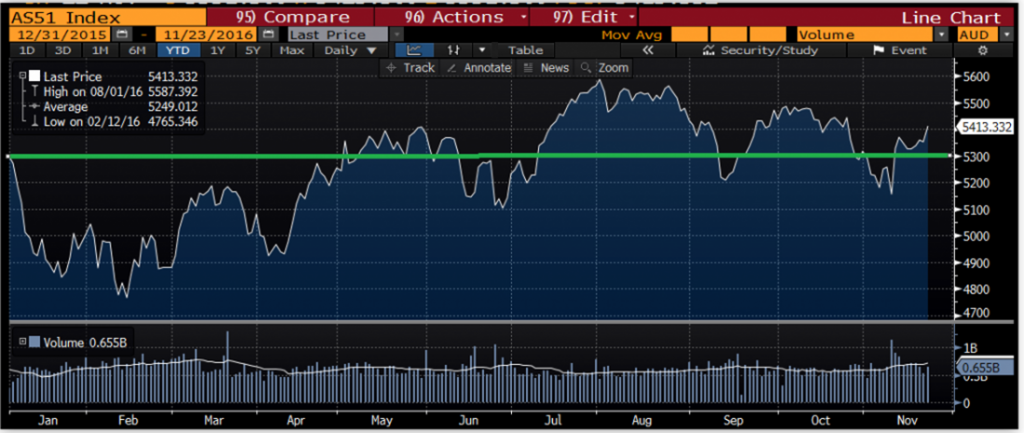With the silly season upon us, it’s the perfect time to reflect on 2016. It’s been a big year for Exchange Traded Products (ETPs) in Australia and around the world, and it’s worth looking at likely developments as we move into 2017 and beyond.
Australia
At the beginning of the year, the ETP industry had about $21.4 billion in assets under management (AUM) across 169 funds. As at the end of October 2016, ETPs had grown to $24.4 billion in AUM across 199 products. An impressive 30 funds have been launched this year as at October end, and there are currently 5 ETPs that have over $1 billion of AUM in the local market.
There have been some major shocks to the global markets in 2016, but the Australian share market is marginally higher than at the beginning of 2016 and may finish even stronger if the late momentum carries on until the end of the year.

Source: Bloomberg
In addition to the 16% AUM growth in ETPs for the last 12 months to October 2016, we also saw record high trading activity levels, up 18% on the previous year. The three biggest increases in AUM occurred across Australian equities, international equities and fixed income products. Strong inflows have continued in reaction to President-Elect Trump’s business-friendly stance and expansionary fiscal policy. There were very little outflows overall for the year, but what did flow out was mostly Asian equities (ex-Japan).
Global
The global ETP industry also produced stellar results for the year to date, although obviously on a much larger scale. According to ETP industry researcher, ETFGI, global ETP assets reached a record US$3.4 trillion at the end of the Q3 2016, about 10% larger than the global hedge fund industry (US$2.9 trillion), after experiencing 32 consecutive months of net inflows.
In the first three quarters of 2016, ETPs saw net inflows of US$238 billion, which is down slightly from the US$252 billion gathered at the same point in 2015. Fixed income ETPs gained the largest net inflows with US$101 billion, which is a record level of YTD net new assets and significantly above the prior YTD record of US$64 billion set in 2015. After fixed income, the next biggest categories for inflows were equity ETPs with US$86 billion and commodity ETPs with US$37 billion.
As at the end of October 2016, there were 6,526 ETPs (+511) issued by 284 providers, being traded on 65 exchanges across 53 countries. These international numbers are truly mind-boggling.
The future
Over 2017, the Australian ETP market is likely to see growth in:
- Factor based products: not exactly active, and not just passive, these ETPs weight by factors other than market cap with the intention of producing alpha by breaking the link between price and portfolio weight.
- Hedged exposures: whilst the AUD has proven resilient over the year, not dropping close to most analysts’ expectations, money has been made on unhedged exposures. In regions such as Europe and Japan, equity markets have historically performed best when their currency is falling, so it is prudent to take a look at exposures hedged and unhedged and select what suits. More options will allow exposures both hedged and unhedged in the Australian market.
- Active exchange traded managed funds: with the success and acceptance of these products in 2016, many more active managers will consider listed versions of their funds in 2017.
- Fixed income products: despite new products, there is room for more with different types of risk.
It was a year of ups and downs for markets generally, but ETPs continued to grow in size and range. Australia has a lot of catching up to the rest of the world in the variety of ETPs, so expect many new products in 2017.
Justin Arzadon is Associate Director, Distribution at BetaShares. This article is general information and does not consider the specific circumstances of any individual. BetaShares is a sponsor of Cuffelinks.